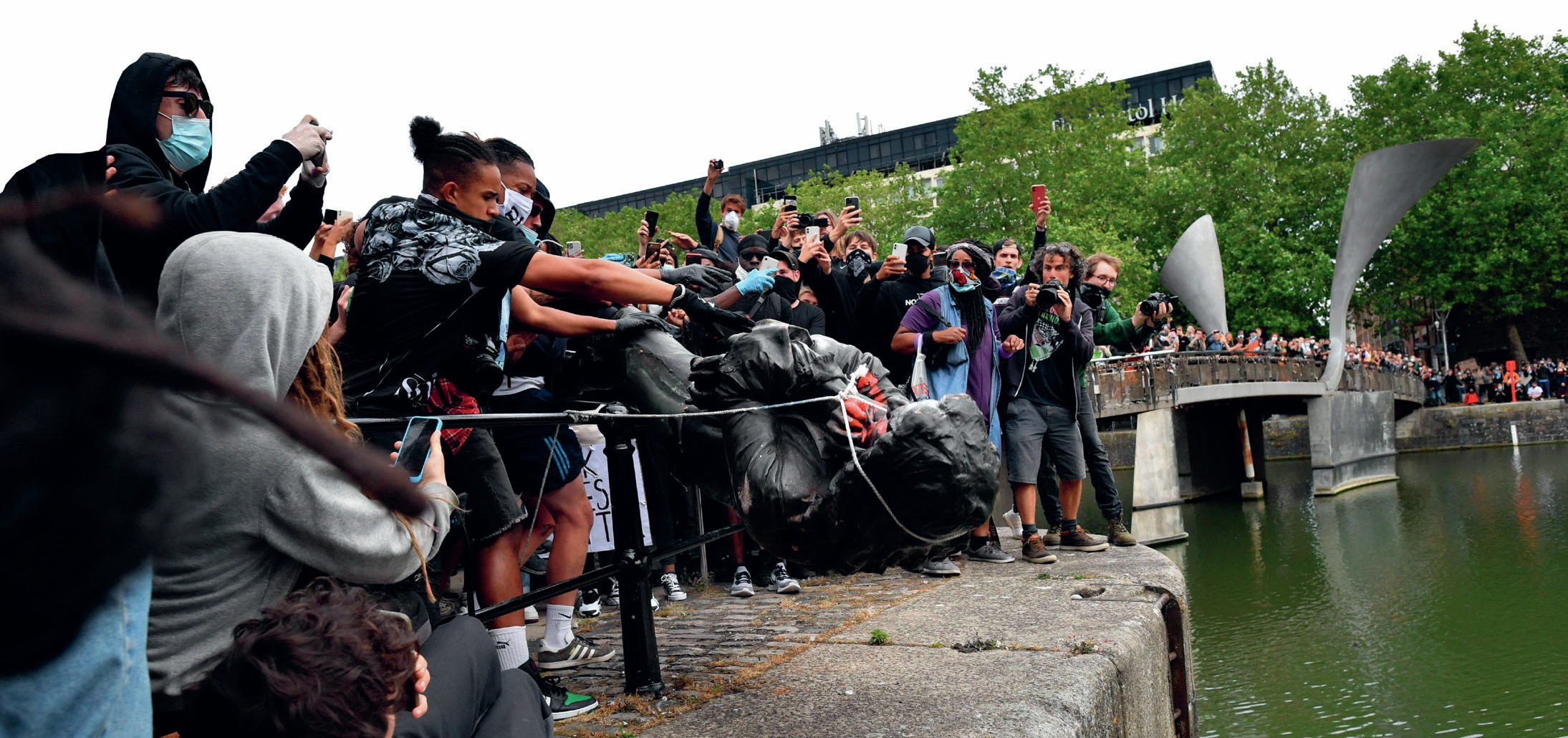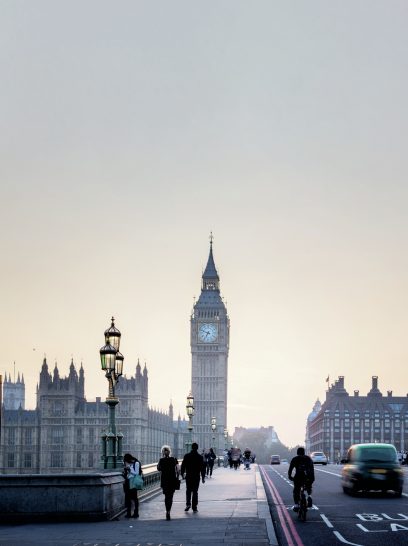The legacies of British slave-ownership
Summer 2020 saw the spread of Black Lives Matter protests around the globe and the removal of numerous statues, such as the one of enslaver Edward Colston in Bristol. In this article, Helen Paul examines the history of the slave trade and its links to industrialisation, as well as renewed discussions around reparations

The charity Anti-Slavery International estimates that 40 million people are trapped in slavery worldwide today. Slavery as an institution can take many forms, but the best-known example is the Transatlantic slave trade, which operated from the sixteenth to nineteenth centuries. In this period, millions of Africans were shipped across the Atlantic in terrible conditions. Many ended up working on plantations growing crops like sugar or cotton, where they were viewed as the legal property of others, with no human rights. Indeed, plantation-owners, called planters, were renowned for their brutality. The horrors of slavery, and the importance of slave labour in economic terms, has led to calls for reparations.
What are reparations?
Reparations are a type of compensation payment, usually in response to warfare or human rights abuses. The term originally referred to compensation paid by one state to another — a nation that had lost a war would pay compensation to the victor to cover the costs of the war.
Postwar examples
A famous example is German reparations after the First World War. The 1919 Treaty of Versailles required Germany to take on the moral blame of beginning the war and to pay heavy reparations or compensation payments. The economist John Maynard Keynes argued that the amount of compensation was too much for Germany to bear and the country would become politically unstable. When Hitler took power, many believed that Keynes had been proved right.

Another example of reparations came after the Second World War, when Israel successfully argued for compensation from the West German government after large numbers of Holocaust survivors settled in Israel. Israel’s argument was that it had to provide healthcare and other social services to the survivors. West Germany agreed to pay compensation to cover some of those costs and signed a deal in 1952, but in recent years, some Israeli politicians have argued that the compensation scheme was insufficient.
In 2000, Germany began a new fund, which involved German firms that used or profited from slave labour during the war, such as Volkswagen and Deutsche Bank. The companies were able to strike a deal which protected them from future lawsuits. This is an important consideration as payment of reparations can open the door to more legal challenges.
Twenty-first century examples
More recent examples include the University of Glasgow’s pledge to spend £20 million on ‘restorative justice’ projects, and the brewer Greene King’s decision to pay reparations in the form of investments to benefit the BAME community (its founder owned over 200 slaves). Both organisations benefit from improved public relations and can dictate how the money is used.
These and other organisations, such as the National Trust, have become part of a recent conversation about the role of slavery in Britain’s development. The public is now more aware of the issue and there is pressure for slaving links to be recognised, and for reparations to be paid. Economic history research can help to uncover hidden connections between British industrialisation and slavery.
However, the examples above highlight some of the main issues surrounding reparations. First, who is to blame and for what? Second, how can we ensure that victims are appropriately compensated? Third, what is a reasonable sum to ask for given current economic circumstances?

Britain’s compensation to enslavers
The Holocaust reparations are a model for claims to make reparations for the slave trade. Holocaust reparations were paid to the State of Israel and organisations representing the victims who were living outside Israel. They would transfer resources to survivors, but also act as heirs for people who had died during the Holocaust. However, there are no living survivors of the Transatlantic slave trade — the last survivor is thought to be Matilda McCrear, who died in 1940.
Who, therefore, should make claims for reparations on behalf of the dead and their descendants? Various Caribbean nations have pressed for reparations, claiming that the effects of slavery are still relevant today.
In 2015, the Jamaican prime minister Portia Simpson Miller raised the issue with British prime minister David Cameron when he visited the island. Cameron argued that Britain’s role in abolishing slavery should be remembered. Ironically, one of the ways that abolition was achieved was through compensation payments. However, these were made to the enslavers and not the enslaved people themselves. In the same year that Cameron visited Jamaica, the British government announced that it had paid off the compensation debt to enslavers — news which provoked further public outcry and scrutiny.
British plantations in the Caribbean after 1807
The compensation in question relates to British Caribbean slave plantations. In 1807, Britain banned its citizens from shipping enslaved people across the Atlantic and the Royal Navy began anti-slavery patrols and stopped slave ships regardless of nationality. Many British people were taught about the importance of 1807 at school, but not about the continuation of slavery on the plantations. In fact, planters were not required to free their slaves until 1833.
The former enslaved people worked for their former owners as ‘apprentices’ —a system that made sure workers were paid sub-standard wages and were not free to move to a different employer. This scheme ended in 1838 when the British government allotted £20 million to compensate enslavers, but nothing for former enslaved people. It had to take out loans to pay this vast sum and British taxpayers were paying off the loan until 2015, although this only became news when the Treasury tweeted about it in 2018.
Researching claimants
The compensation scheme had largely been forgotten about. In 2009, a team of researchers began investigating the records of the compensation claims made. The papers listed the claimants and information about them, but also about the enslaved people they were making claims for. The research was useful for a number of reasons.
First, it showed that many enslavers were actually resident in Britain rather than the Caribbean. Second, it made it possible to see how compensation money was spent. For example, a variety of charities, stately homes and commercial projects were partly paid for in this way. Third, it gave us an insight into the lives of the enslaved people themselves — there were details about some individual slaves in the documents. The Legacies of British Slave-ownership (LBS) database is freely available online and has been an important tool in demonstrating how money from slave-ownership provided funding for important aspects of British industrialisation, such as railway companies or banks.
Industrial development
Economic historians have long argued that British industrialisation was linked to slavery. Joseph Inikori made that argument in his book Africans and the Industrial Revolution in England, and the LBS database research helps to confirm his views. The port cities of Bristol and Liverpool have acknowledged that their development was dependent on the slave trade. Both cities specialised in it and as a result, a service sector sprung up to cater for the financing and insurance needs of slavers. Manufacturers produced goods which would be taken to the African coast to exchange for enslaved people.
Bristol and Liverpool both have slavery museums set up to acknowledge the past. However, the LBS demonstrated to the public that money did not just flow to those cities but across the whole of Britain. For example, it shows that millions of pounds were invested in railway infrastructure. Private companies would build a stretch of railway and sell shares to raise funds. Railways schemes began to appear in the 1830s, just in time for former enslavers to re-invest their capital.
Slave-ship building
Other economic history projects have focused on a single city. Swansea is a good example. It developed around the copper industry but was financed by Bristol investors. Bristol slave-shippers needed copper for a variety of reasons, including to make metalware for the African market, sugar boiling pans for the Caribbean sugar plantations, and above all sheathing for ships.
Wooden hulls were vulnerable to attacks by teredo worm (also known as ship worm), which ate away at the ships and was particularly problematic in warmer tropical waters. Hulls covered with expensive copper sheathing could move more easily through the water. This made Transatlantic voyages shorter, which in turn meant that more enslaved people were likely to survive the journey. Peter M. Solar and Klas Rönnbäck published an article in Economic History Review arguing that copper sheathing reduced onboard death rates by half. They state that the costs of the copper sheathing were more than covered by the higher survival rates of enslaved people.
Copper was very expensive and required a great deal of energy to produce. Only the vast profits from the slave trade seem to have made copper smelting worthwhile. Bristol slave merchants originally sourced copper ore from Cornwall and smelted it near to Bristol, but Swansea, then a small town, was deemed to be an ideal location. Copper ore could be taken there by sea from Cornwall or from Anglesey and nearby Welsh coalfields could provide the energy needed.
Thus, Swansea became a major city due to its copper industry and was nicknamed Copperopolis. Eventually it imported copper ore from as far away as Cuba. It became an important industrial centre, but it owes its development to the needs of the slave trade.
The LBS database can be used to investigate further. Here are some examples. Pascoe Grenfell was a copper entrepreneur, whose firm dominated copper smelting in the Swansea Valley from the 1820s to the 1890s. Grenfell’s son was a London banker whose firm was awarded compensation by the British government for enslaved people in Jamaica. Another important Swansea copper family were the Mackworths, who also put in a claim for slaves in Trinidad. Families like the Grenfells and the Mackworths were able to move out of slave ownership and invest their money elsewhere as Britain industrialised.

Compensation and reparations
The scale of Britain’s involvement in slavery is still not yet fully understood. Indeed, in 2018, people were shocked to learn they (as taxpayers) had been paying off the loans for enslavers compensation payments.
The publicly available LBS database allows people to see how that money was spent. Ironically, the records of the owner compensation payments have been used to claim reparations for slavery. As detailed, both whole cities and areas of the country developed as a result of the slave trade.
Individuals and companies also profited, both through the use of slave labour and the compensation payments they received upon abolition. The LBS was used to investigate the payments made to Benjamin Greene, of the brewing firm Greene King. The company was then prompted to make amends. As research continues, we are likely to see more reparation schemes in the future.
SPECIFICATION LINKS
manufacturing, industry, labour, inequality
KEY POINTS
1 Through the Atlantic slave trade, millions of Africans were forced into slavery where they faced brutality and had no human rights.
2 Reparations are payments to compensate an individual or nation for wrongdoing. There have been calls for reparations related to the slave trade to be paid.
3 The justification for reparations rests on both the immorality of the slave trade and the economic advantages that some gained from it.
4 Historical research has shown the economic impact of the slave trade in the UK, including developments of cities, ports and industries.
5 Former enslavers benefited from compensation payments upon the abolition of slavery, and were able to reinvest the money.
6 Research has uncovered the trail of this money leading to increased calls for reparations.





